ES6
in production
Goals
- JavaScript in 2016
- All things ES6
- What's next? (ES2016)
Bård
@bardguyver
About me
Front-End Dev @ CDD
About me
BaþufriþuR
baþu
friðr
Bárðr
Bård
About me

About me

About me

About me

About me

About me

Agenda
JavaScript in 2016
ES6/2015
browser support
Babel
New features
Updating ES5 library
ES7/2016 and beyond
Final thoughts
Agenda - features
arrows
classes
enhanced object literals
template strings
destructuring
default + rest + spread
let + const
iterators + for..of
generators
unicode
modules
modules
module loaders
map + set
weakmap + weakset
proxies
symbols
subclassable built-ins
promises
library APIs
binary and octal literals
reflect api
Agenda - features
let, const
destructuring
arrow functions
blocks
template strings
modules
def. parameters
concise methods
for of
classes
object.assign
promises
strings
bonus level
final exams
parameters
2
1
3
5
4
6
8
7
9
11
10
12
13
14
?
99
Agenda - quiz slides
get ready...
Quiz time!
Who is this?

Quiz time!
Bennett from commando!

JavaScript in 2016

JavaScript in 2016
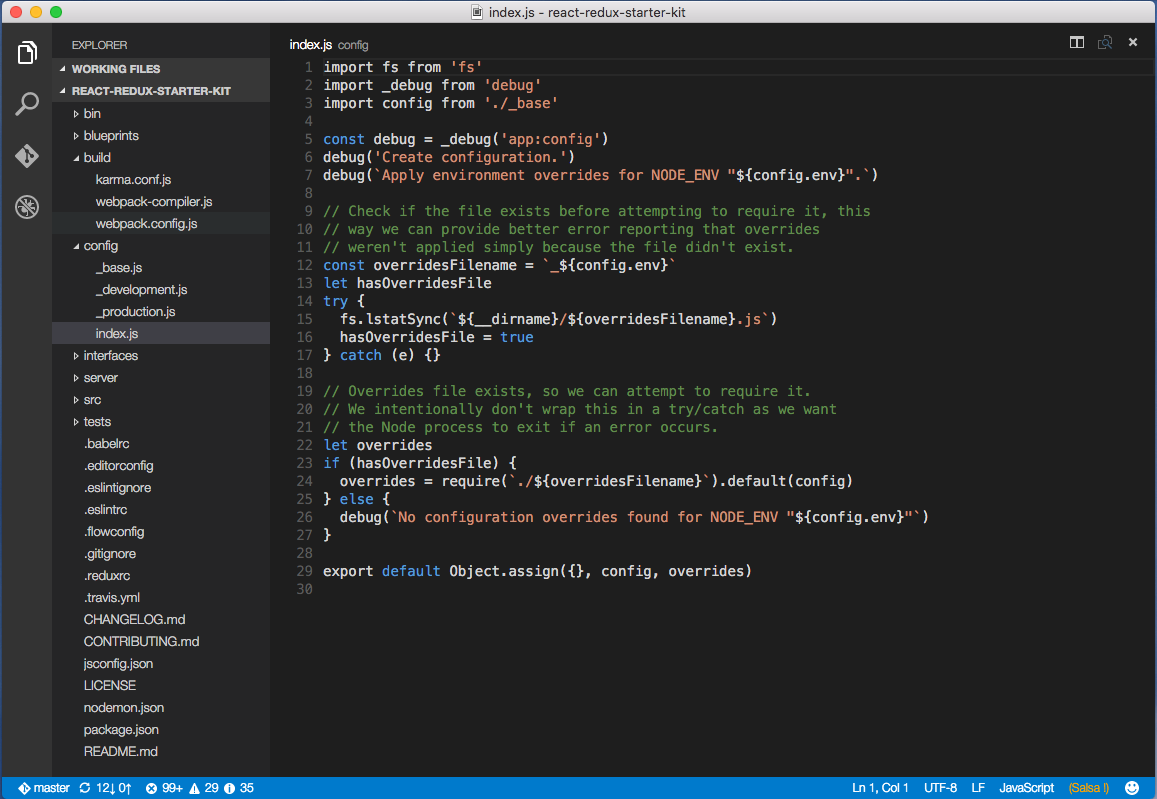
JavaScript in 2016

JavaScript in 2016

JavaScript in 2016
- SPA's are hard to do (right)
- State is hard to manage
JavaScript in 2016

JavaScript in 2016:
Image source: https://blog.formidable.com/using-react-is-a-business-decision-not-a-technology-choice-63c4641c5f7#.2crsz2ky1
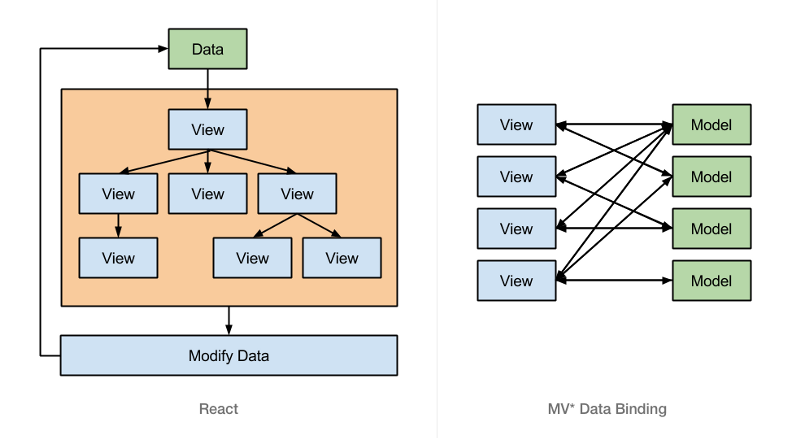
JavaScript in 2016
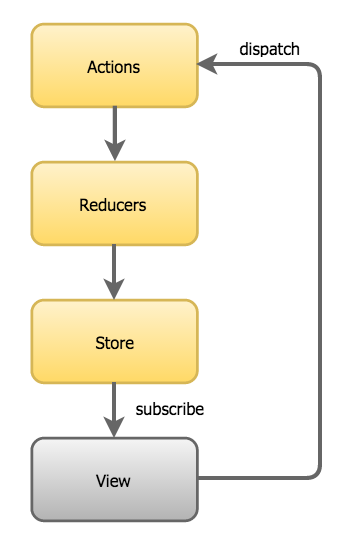
Redux
JavaScript in 2016: Tay

JavaScript in 2016: Bower

JavaScript in 2016
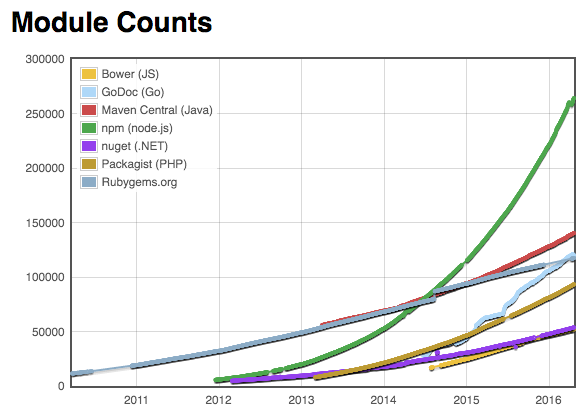
JavaScript in 2016

JavaScript in 2016

JavaScript in 2016: left-pad

Azer
vs
kik
(messaging app)
left-pad
module.exports = leftpad;
function leftpad (str, len, ch) {
str = String(str);
var i = -1;
if (!ch && ch !== 0) ch = ' ';
len = len - str.length;
while (++i < len) {
str = ch + str;
}
return str;
}JavaScript in 2016
The aftermath
- Better unpublishing rules from npm
- A lot of angry blog posts
- Questions about external dependencies
JavaScript in 2016

ES2015
- Adopt features one at a time!
- Landed in a turbulent time
- Not an all-or-nothing deal
ES2015 - Names & acronyms
ECMA
ECMAScript
javaScript
VBScript
JScript
ActionScript
LiveScript
Harmony
TC39
ES.next
ES2015
ES2016
ES2017
ES2
ES3
ES4
ES5
ES6
ES7
ES8
ES2015 - Names & acronyms
JavaScript
1995
2009
ECMAScript
(liveScript)


1996
ECMA
jScript
ES2, ES3
98/99
ActionScript
VBScript
JavaScript
ES5
2015
ES6
TC39
ES3.1
ES.next
Harmony

ES4

ES2016
ES2017
ES7
ES8
ES2015: Stages
Stage 0: strawman
Stage 1: proposal
Stage 2: draft
Stage 3: candidate
Stage 4: finished
ES2015: Stages
One of the things the committee really focuses on, and this is something that's been really healthy, is primitives.
We're looking not necessarily to innovate. We're looking to find what people are really doing out there on the web. We're looking to enable them to build features themselves.
ES2015: Stages
Quiz time!
20
150
x
3
Quiz time!
20
150
x
3
= 1000
ES2015 - Features
live slides:
let, const
1
let, const
`let` and `const` are new block-scoped variable declaration statements.
let, const: hoisting
// Hoisting 101
function hoistMe() {
var x = 31;
var x = 71;
if (true) {
console.log(x);
}
console.log(x);
}
// Hoisting 101
function hoistMe() {
var x = 31;
if (true) {
var x = 71;
console.log(x);
}
console.log(x);
}
// Hoisting 101
function hoistMe() {
var x = 31;
if (true) {
var x = 71;
console.log(x); // 71
}
console.log(x); // 71
}
let, const: Example
// var, let and const are available in all sub-blocks
var varName = 'Angus';
let letName = 'Angus';
const constName = 'Angus';
if (true){
console.log(varName); // Angus
console.log(letName); // Angus
console.log(constName); // Angus
varName = 'Donna';
letName = 'Donna';
constName = 'Donna'; // ERROR!
}
console.log(varName); // Donna
console.log(letName); // Donna
console.log(constName); // Anguslet, const: Example 2
// But only var is available outside of block scope
if (true){
var varName = 'Angus';
let letName = 'Angus';
const constName = 'Angus';
}
console.log(varName); // Angus
console.log(letName); // letName is not defined
console.log(constName); // constName is not definedlet, const: let
for (let i = 0; i > 5; i++) {
console.log(i); // 0, 1, 2, 3, 4
}
for (let i = 0; i > 5; i++) {
console.log(i); // 0, 1, 2, 3, 4
}
console.log(i); // ReferenceError: i is not defined
if (true){
let letName = 'fritz';
}
console.log(letName); // ReferenceError: i is not definedlet, const: const
// const with int value
const year = 2016;
year = 2017; // Error!
const person = {};
person.name = 'Ingrid';
person.age = 32;
person = { 'name' : 'Ingrid' }; // Error!
person = 'test'; // Error!
let, const: Best practice
let, const: Use case
const
let
var
New default variable declaration statement
Use to indicate variable will change over time
Use to indicate legacy code
let, const: Best practice
const is the new var.
But: Don't blindly refactor all var instances as this can create side effects. (hoisting)
Template strings
2
Template strings
Template strings allow you to mix strings, variables and functions.
template strings: Example
// ES5
var person = {
name: 'Jon Snow',
status = 'dead'
}
console.log('I\'m pretty sure ' + person.name + ' is ' + person.status);
// ES6
const person = {
name: 'Jon Snow',
status = 'alive'
}
console.log(`I've read online that ${person.name} is ${person.status}`);
template strings: Example
// No more newline characters
// ES5
console.log('string text line 1\n\ string text line 2');
// ES6
console.log(
`string text line 1
string text line 2`
); template strings: Use case
- Use for string & variable mixing
- Use for multi-line strings
Default parameters
3
Default parameters
Allows parameters to be given a default value.
Default parameters: Example
// Basic example
function add(x=0, y=0) {
return x + y;
}
add(); // 0
add(1); // 1
add(2, 3); // 5Default parameters: Example
// ES5
var datingProfile = function(name, interests) {
if (name === undefined) {
name = 'John';
}
if (interests === undefined) {
interests = 'most forms of data processing';
}
return 'Hi, I\'m ' + name + ', and I like ' + interests;
};// ES6
const datingProfile = function(name = 'Sal', interests = 'eels') {
return `Hi, I'm ${name}, and I like ${interests}`;
};Default parameters: Use case
Remove boilerplate
Quiz time!
Who is this?

Answer:
Murdoc!
MacGyver's nemesis...

Arrow Functions
4
Arrow functions
Arrow functions are function shorthands
Arrow functions doesn't create a new 'this' context.
Arrow functions: Concept
// ES5 function
const person = {
greet: function(name) {
return `hi, ${name}`;
}
}// Arrow function
const person = {
greet: (name) => {
return `hi, ${name}`;
}
}// Implicit return
const person = {
greet: (name) => `hi, ${name}`
}Arrow functions: Example
// ES5 - Movie plot generator
const plots = [
'avenge dead wife',
'use skillset to eliminate threat to nation',
'save daughter'
];
const createMoviePitch = function(plot) {
console.log(`Liam Neeson has to ${plot}`);
};
// Make it rain!
plots.map( function(plot) {
return createMoviePitch(plot)
});Arrow functions: Example
// ES6 - Movie plot generator
const plots = [
'avenge dead wife',
'use skillset to eliminate threat to nation',
'save daughter'
];
const createMoviePitch = function(plot) {
console.log(`Liam Neeson has to ${plot}`);
};
// Make it rain!
plots.map( (plot) => {
return createMoviePitch(plot)
});Arrow functions: Example
// ES6 - Movie plot generator
const plots = [
'avenge dead wife',
'use skillset to eliminate threat to nation',
'save daughter'
];
const createMoviePitch = (plot) => {
console.log(`Liam Neeson has to ${plot}`);
};
// Make it rain!
plots.map( plot => createMoviePitch(plot));Arrow functions: Anatomy
// Passing arguments
() => { ... } // no argument
x => { ... } // one argument
(x, y) => { ... } // several arguments
// Function bodies
x => { return x * x } // block
x => x * x // expression, equivalent to previous lineArrow functions: `this`
// ES5
function sneeze() {
var self = this;
console.log('ahh.. ahh.. ahh..');
this.choo = function(){
console.log('CHOO!');
};
window.setTimeout( function() {
self.choo();
}, 1000);
}// ES6
function sneeze() {
console.log('ahh.. ahh.. ahh..');
this.choo = () => console.log('CHOO!');
window.setTimeout( () => {
this.choo();
}, 1000);
} Arrow functions: Use case
- anonymous functions
- when you need 'this' to stay in parent context
- When using map, filter, reduce
Destructuring
5
Destructuring
Easily extract values from data stored in objects and Arrays
Destructuring: Example
// ES5 object creation
const person = {
name: 'Tim Samson',
features: {
face: 'round',
arms: 'sort',
hair: false
}
}
// Imagine if you had to do this instead:
const person = {};
person.name = 'Tim Samson';
person.features = {};
person.features.face = 'round';
person.features.arms = 'sort';
person.features.hair = false;Destructuring: Example
// ES5 data extraction
const person = {
name: 'Tim Samson',
features: {
face: 'round',
arms: 'sort',
hair: false
}
}
// To get values out with ES5 you had to dig!
const name = person.name;
const face = person.features.face;
const arms = person.features.arms;
const hair = person.features.hair;// ES6 data extraction
const person = {
name: 'Tim Samson',
features: {
face: 'round',
arms: 'sort',
hair: false
}
}
// To get values out with ES5 you had to dig!
const name = person.name;
const face = person.features.face;
const arms = person.features.arms;
const hair = person.features.hair;
// Not anymore!
const { name, features: { face, arms, hair } } = person;Destructuring: argument
// Useful when you only care about certain parameters
const menu = {
appetiser: 'flea soup'
mains: 'locust eggs'
dessert: 'goblin sorbet'
}
function orderDessert({dessert}){
console.log(`Can I please have a bucket of ${dessert}, please?`);
}
orderDessert(menu); // Can I please have a bucket of goblin sorbet, please?Destructuring: defaults
// Provide a default value if property doesn't exist
const person = {
name: 'Draco',
age: 673
}
const { name = 'Ricardo', height = '180cm' } = person;
console.log(name); // Draco
console.log(age); // 673
console.log(height); // 180cmDestructuring: defaults
// Variable unpacking - common react pattern
// ES5
var author = this.props.author;
var posts = this.props.posts;
var bio = this.props.bio;
// ES6
const { author, posts, bio } = this.props; Destructuring: Use case
- get data from JSON/objects
- provide default variable values
- destructure function arguments
Modules
6
Modules
Modules bring module loading to native javaScript
modules: Basic example
/**
* CommonJS (Node)
*/
var _ = require('lodash');
_.join(['a', 'b', 'c'], '~'); // → 'a~b~c'
/**
* AMD (RequireJS)
*/
define(['lodash'] , function (_) {
return function () {
_.join(['a', 'b', 'c'], '~'); // → 'a~b~c'
};
});
/**
* ES6 modules
*/
import _ from 'lodash';
_.join(['a', 'b', 'c'], '~'); // → 'a~b~c'modules: Named Exports
// --- animalFarm.js --- //
export const napoleon = {
species = 'pig',
speak() => { console.log('Four legs good, two legs bad'); }
};
export const boxer = {
species = 'horse',
speak() => { console.log('I will work harder'); }
};
// --- main.js --- //
// Named imports
import { napoleon, snowball } from 'animalFarm';
napoleon.speak();
// Import all the things
import * as animalFarm from 'animalFarm';
animalFarm.boxer.speak();modules: Default exports
// --- helpers.js --- //
// Default exports
var helpers = {
generateRandom: function() {
return Math.random();
},
sum: function(a, b) {
return a + b;
}
};
export default helpers;
// --- main.js --- //
import helpers from 'helpers';Modules: Use case
- The new standard module syntax
- To use modules today you need some sort of bundler like browserify or webpack.
Blocks
7
Blocks
the End of the IIFE
Blocks

Blocks: Example
// ES5
(function () {
var secret = 'Soylent green is people!';
}());
console.log(secret); // Reference Error
// ES6
{
let secret = 'Bush faked the moon landing';
}
console.log(secret); // Reference ErrorBlocks: Use cases
- Wherever you used IFFE's before
- To create a new block scope context
Quiz time!
Add up n'th character

then reverse

(of first names)
2
4

3

1
Quiz time!
Add up n'th character

then reverse

(of first names)
2
4

3
1
hal

Quiz time!
ABBA

hal
donald

2
4

3
jeb
bonnie
1

Enhanced Object Literals
8
Enhanced Object Literals
Object literals have been given more functionality with ES6.
-
Shorthands for defining methods
- Dynamic property names
Enhanced Objects: Example
// ES5
var person = {
name: 'Doyle',
poke: function() { console.log('Stop that!'); },
greet: function() { console.log('Ahoi-hoi!'); }
};
// ES6
var person = {
name: 'Doyle',
poke() { console.log('Stop that!'); },
greet() { console.log('Ahoi-hoi!'); }
};Enhanced Objects: Example
// Computed property names (ES6)
const prefix = 'half';
const people = {
[prefix + 'man']: 'Tyrion',
[prefix + 'hand']: 'Qhorin',
[prefix + 'mast']: true
};
console.log(people.halfman); // → Tyrion
console.log(people.halfhand); // → Qhorin
console.log(people.halfmast); // → trueEnhanced Object: Use case
- Creating object methods
- Computed property names
Parameters
9
Parameters
There's a few new ways of managing parameters in ES6:
- Default parameters (already covered)
- Rest parameters
- Spread operators
Rest Parameters: Example
const arguments = ['test', 'test2', 'okay', 2, {}, null];
// ES5
function printAllArguments1() {
for (var i=0; i < arguments.length; i++) {
console.log(arguments[i]);
}
}
printAllArguments1(); // → test, test2, okay, 2, {}, null// ES6
function printAllArguments2(...things) {
things.forEach( thing => {
console.log(thing);
});
}
printAllArguments1(); // → test, test2, okay, 2, {}, nullSpread operator: Example
var args = [0, 1, 2];
function myFunction(x, y, z) { }
// ES5
myFunction.apply(null, args);// ES6
myFunction(...args);
// Or even
myFunction(...[1,2,3]);A better apply
Promises
10
P
Promises
Promises are perhaps the most important new feature.
- Lots of 3rd party libraries implement promises
- Node developers have been using them for a long time
- Finally a native implementation
- Used under the hood for a lot of upcoming async features
Promises
A promise is a representation of the eventual result of an async computation
- A more familiar example
Promises
- Synchronous code = easy
Why are they needed?
- Error handling in callbacks are hard
- Async is hard
- Pyramid of doom (Callback hell)
Promises
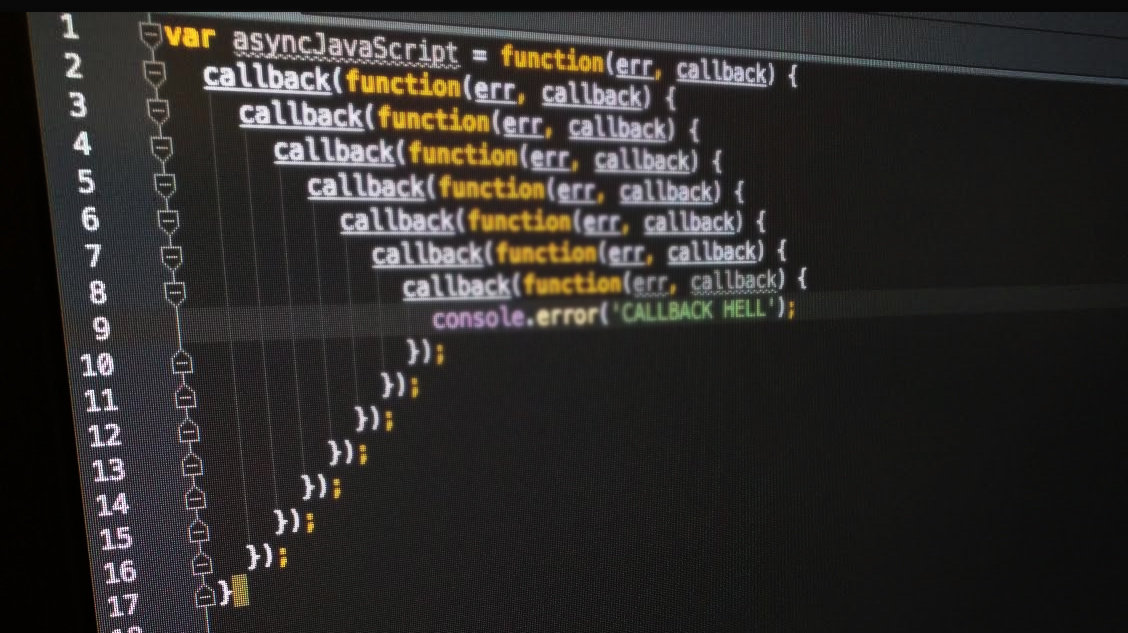
Promises: Example
// ES5
func1(function (value1) {
func2(value1, function (value2) {
func3(value2, function (value3) {
func4(value3, function (value4) {
// Do something with value 4
});
});
});
});
// ES6
func1(value1)
.then(func2)
.then(func3)
.then(func4, value4 => {
// Do something with value 4
});Promises: Syntax
// Promise creation
promise = new Promise(function(resolve, reject) {});- The promise constructor takes one argument, a callback with two parameters, resolve and reject.
- Running new Promise will immediately call the function passed in as an argument.
Promises
A promise is a special kind of javascript object which contains another object.
Promises: Creating a new promise
const promise = new Promise(
function (resolve, reject) {
// Do something async here!
setTimeout(() => resolve({name: 'Bård'}), 2000)
// Or, with ES5 syntax:
setTimeout( function(){
return resolve({name: 'Bård'})
}, 2000)
}
);Promises
.then() is used to get the data stored in a promise
Promises: Executing
getName.then(function(user) {
// process result
console.log(user.name)
}, function(err) {
// handle error
console.log('error! error!')
});Promises: States
Promises start out in pending state and are settled when they’re either fulfilled or rejected
pending
rejected
fulfilled
settled
Promises: .then()
.then() is the most important method
- registers callbacks to receive either the eventual value or the reason why the promise cannot be fulfilled
- accepts two arguments (Both are optional, can add a callback for the success or failure case only)
- then always returns a new promise
Promises: .then()
// Basic usage
.then(successFn, errorFn)
// Chaining
getSomeData()
.then(filterTheData)
.then(processTheData)
.then(displayTheData);Promises: Promise.all
- Returns a promise which resolves when all of it’s argument promises have resolved
- Or: is rejected when any of it’s argument promises are rejected
Promises: Promise.all()
// Syntax
Promise.all(promiseArray).then(function(resultsArray) {
//...
});
// Example:
Promise.all([
queryUserToken(),
queryUserDetails()
]).then(function() {
renderProfiles();
});Promises: Error handling
keep your Promise chains flat with a trailing .catch() to properly handles errors
- Easier than in callback pyramids
- Promises are implemented to allow a single channel for errors
- .catch() is better than using .then(errorFn)
Promises: Error catching
// Error catching
getSomeData()
.then(doSomething)
.then(doSomethingElse)
.catch(function(err) {
// handle all errors
});Promises Use cases
- Working with async data
- Concurrent async requests
- REST etc
Object.assign
11
P
Enhanced Object Literals
works like jquery.extend
Object.assign: Example
// Syntax
Object.assign(targetObj, source, source2, source3);
const o1 = { a: 1 };
const o2 = { b: 2 };
const o3 = { c: 3 };
const newObj = Object.assign(o1, o2, o3);
console.log(newObj); // { a: 1, b: 2, c: 3 }Object.assign: Example 2
function UIModal(userOptions) {
const DOM;
const defaults = {
modal: '.js-modal',
openBtn: '.js-modal-btn',
closeBtn: '.js-modal-close-btn',
overlay: '.js-modal-overlay',
showOverlay: true
};
// Combine defaults with passed in options
const settings = Object.assign(defaults, userOptions);
// ...
}Object.assign: Use case
- Config objects
- Combining multiple objects
Quiz time!
What is this?

Quiz time!


for-of
12
for-of
Like for-in, but returns object, not index.
for-of: Example
// ES5
var sum1 = 0;
var arr1 = [1, 2, 3];
for (var index in arr1) {
sum += arr1[index];
}
// ES6
let sum2 = 0;
let arr2 = [1, 2, 3];
for (let value of arr2) {
sum += value;
}for-of: Example
// Strings
let iterable = "Jammie Dodgers";
for (let value of iterable) {
console.log(value);
}
// J
// a
// m
// m
// i
// e
//
// D
// o
// d
// g
// e
// r
// sfor-of: Use case
- Iterating over objects and arrays
- Watch out for future uses (observables)
strings
13
Strings
The string native has been extended with some very useful new features
Strings: string.includes()
// ES5
console.log('devSouthCoast'.indexOf('Coast') > -1);
// true
// ES6
console.log('ryanGoslin'.includes('Goblin'));
// falseStrings: string.repeat()
// ES5
function repeat(string, count) {
var strings = [];
while(strings.length < count) {
strings.push(string);
}
return strings.join('');
}
repeat('chill', 3); // 'chillchillchill'
// ES6
'go'.repeat(3); // 'gogogo' Strings: Use case
- When you need string includes & repeat functions...
classes
14
Modules
Simple sugar over the prototype-based OO pattern
Classes: Example
// Basic syntax
class className {
// Constructor
constructor() {}
// Method
methodName(){}
// Super call
super.superMethod();
}Classes: ES5
// ES5
function Person(name, age, species) {
this.name = name;
this.age = age;
this.species = species;
}
Person.prototype.greet = function () {
return 'Greetings, I am ' + this.name + '!';
};
var cindy = new Person('Cindy', 98, 'klingon');
console.log(cindy.greet()); // Greetings, I am Cindy!Classes: ES6
// ES5
class Person {
constructor(name, age, species) {
this.name = name;
this.age = age;
this.species = species;
}
greet() {
return 'Greetings, I am ' + this.name + '!';
}
}
const cindy = new Person('Cindy', 98, 'klingon');
console.log(cindy.greet()); // Greetings, I am Cindy!Classes: Use case
- Same as before
- Just sugar..
- Babel demo?
Babel

Babel
- Transpiles ES6 to ES5
- Polyfills complex features
P
- .babelrc
Babel
ES5 library update
ES7/ES2016 and beyond
What's next!?
bonus
ES7/ES2016:
- Array.prototype.includes
- Exponentiation Operator
That's it!
Array.prototype.includes
// Example
['a', 'b', 'c'].includes('a'); // true
['a', 'b', 'c'].includes('d'); // false
// Almost the same Async
['a', 'b', 'c'].indexOf('a') >= 0
// But not quite
[NaN].includes(NaN) // true
[NaN].indexOf(NaN) // -1Exponentiation Operator
// ES5
Math.pow(x, y);
// ES6
x ** y;
// Example
const twoTimesTwo = 2 ** 2; // 4
const fourTimesFourTimesFour = 4 ** 3; // 64
ES7/ES2016 and beyond
What else?

Web Assembly (wasm)
- Low level binary compile target
- Heavy duty applicaitons and games
- Level the playing field for other languages
Web Assembly (wasm)
WebAssembly fills in the gaps that would be awkward to fill with JavaScript
- Not a JavaScript replacement
- Compilation target for other languages
ES7/ES2016 and beyond
Other upcoming ES features?
- Async Await
Async Await
Write syncronous code, make it act asynchronous
- Relies on promises (ES6 core function)
- functions in exactly the same way as calling `.then()` on a promise
- simply pauses execution of a method until the value from the promise is available.
Async Await: The problem
// Async function
function getStarship() {
return fetch('URL').then( response => {
return response.json().name;
})
}
// Sync function
function printStarship() {
const starship = getStarship();
console.log(starship);
}
printStarship(); // undefinedAsync Await: The solution
// Async function
function getStarship() {
return fetch('URL').then( response => {
return response.json().name;
})
}
// Async await function
async function printStarship() {
const starship = await getStarship();
console.log(starship);
}
printStarship(); // Death StarAsync await vs promises
Async Await functions in exactly the same way as calling `.then()` on a promise
(but without requiring any callback function)
Promises vs Async Await
// Promise
function getDailyJoke() {
fetch('http://joke.org', {}).then(function(response) {
return response.body.joke;
});
}
// Async await
async function getDailyJoke() {
let response = await fetch('http://joke.org', {});
return response.body.joke;
}Async Await: Use case
- Write code as if it is sync (readable)
- Code = easier to understand and simpler to write.
Final thoughts
Is ES6 worth the effort?
- Compilers aren’t going away
- less code is better. Less room for error.
- Not an all-or-nothing deal
- Adoption will happen. Typescript etc
Quick wins
- End of callback hell (promises)
- No more `self = this` (arrows)
- Less data validation in functions (default parameters)
- Super-easy object value extraction (destructuring)
Words of caution
- Workflow integration could be painful
- Concern about amount of features?
- Debugging does become slightly harder (but only slightly)
When uncertain, chances are you probably should default to ES5 and older syntax instead of adopting ES6 just because you can.
Words of caution
By this I don’t mean that using ES6 syntax is a bad idea – quite the opposite, see I’m writing an article about ES6!
My concern lies with the fact that when we adopt ES6 features we must do it because they’ll absolutely improve our code quality, and not just because of the "cool factor" – whatever that may be.
My advice
Don't get fatigued! Keep it simple!

Final Quote
There are only two kinds of languages: the ones people complain about and the ones nobody uses
- Bjarne Stroustrup
Final Exams
99
Thanks for listening!
all material & slides: